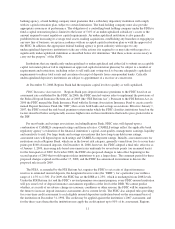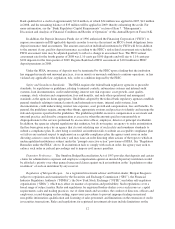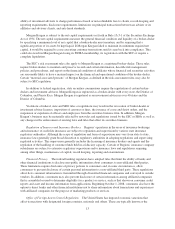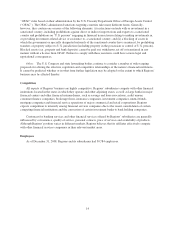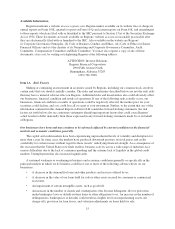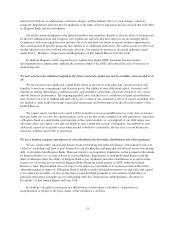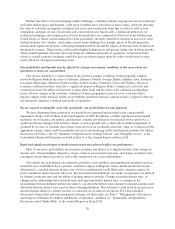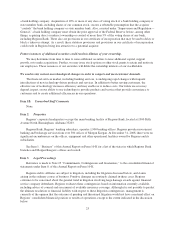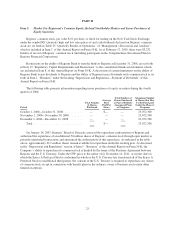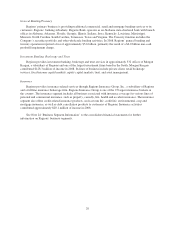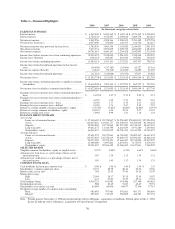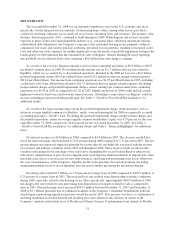Regions Bank 2008 Annual Report Download - page 31
Download and view the complete annual report
Please find page 31 of the 2008 Regions Bank annual report below. You can navigate through the pages in the report by either clicking on the pages listed below, or by using the keyword search tool below to find specific information within the annual report.Our net interest margin depends on many factors that are partly or completely out of our control, including
competition, federal economic monetary and fiscal policies, and general economic conditions. Despite our
strategies to manage interest rate risks, changes in interest rates can still have a material adverse impact on our
businesses, financial condition and results of operations.
The performance of our investment portfolio is subject to fluctuations due to changes in interest rates and
market conditions.
Changes in interest rates can negatively affect the performance of most of our investments. Interest rate
volatility can reduce unrealized gains or create unrealized losses in our portfolios. Interest rates are highly
sensitive to many factors, including governmental monetary policies, domestic and international economic and
political conditions, and other factors beyond our control. Fluctuations in interest rates affect our returns on, and
the market value of, our investment securities.
The fair market value of the securities in our portfolio and the investment income from these securities also
fluctuate depending on general economic and market conditions. In addition, actual net investment income and/or
cash flows from investments that carry prepayment risk, such as mortgage-backed and other asset-backed
securities, may differ from those anticipated at the time of investment as a result of interest rate fluctuations. See
the “Securities” section of Item 7. “Management’s Discussion and Analysis of Financial Condition and Results
of Operation” of this Annual Report on Form 10-K.
Hurricanes and other weather-related events could cause a disruption in our operations or other
consequences that could have an adverse impact on our results of operations.
A significant portion of our operations are located in the areas bordering the Gulf of Mexico and the
Atlantic Ocean, regions that are susceptible to hurricanes. Such weather events can cause disruption to our
operations and could have a material adverse effect on our overall results of operations. We maintain hurricane
insurance, including coverage for lost profits and extra expense; however, there is no insurance against the
disruption to the markets that we serve that a catastrophic hurricane could produce. Further, a hurricane in any of
our market areas could adversely impact the ability of borrowers to timely repay their loans and may adversely
impact the value of any collateral held by us. Some of the states in which we operate have in recent years
experienced extreme droughts. The effects of past or future hurricanes, droughts and other weather-related events
are difficult to predict, but could have an adverse effect on our businesses, financial condition and results of
operations.
Our participation in the U.S. Treasury’s CPP imposes restrictions and obligations on us that limit our ability
to increase dividends, repurchase shares of our common stock and access the equity capital markets.
On November 14, 2008, we issued and sold preferred stock and a warrant to purchase our common stock to
the U.S. Treasury as part of its CPP. Prior to November 14, 2011, unless we have redeemed all of the preferred
stock or the U.S. Treasury has transferred all of the preferred stock to a third party, the agreement pursuant to
which such securities were sold, among other things, limits the payment of dividends on our common stock to the
current quarterly dividend of $0.10 per share without prior regulatory approval, limits our ability to repurchase
shares of our common stock (with certain exceptions, including the repurchase of our common stock to offset
share dilution from equity-based compensation awards), and grants the holders of such securities certain
registration rights which, in certain circumstances, impose lock-up periods during which we would be unable to
issue equity securities. In addition, unless we are able to redeem the preferred stock during the first five years, the
dividends on of this capital will increase substantially at that point, from 5% ($175 million annually) to 9% ($315
million annually). Depending on market conditions at the time, this increase in dividends could significantly
impact our liquidity. See “Regulation and Supervision—U.S. Treasury Capital Purchase Program.”
21


